The Dynamic Spinal Tethering Systems Market is estimated to be valued at USD 79.5 million in 2025 and is projected to reach USD 206.1 million by 2035, registering a compound annual growth rate (CAGR) of 10.0% over the forecast period.
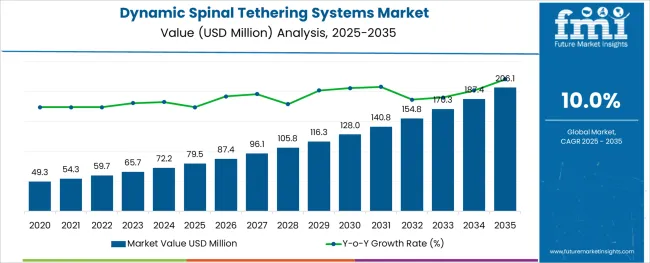
The dynamic spinal tethering systems market is witnessing significant growth due to the increasing adoption of innovative treatments for spinal deformities. Growing awareness of minimally invasive alternatives to traditional spinal fusion surgeries has led to broader acceptance of tethering systems. Advances in biomaterials and surgical techniques have improved patient outcomes, promoting their use especially in younger populations.
Clinical findings emphasize the benefits of preserving spinal mobility while correcting deformities, driving interest in dynamic systems. Pediatric cases dominate the patient population, reflecting early intervention strategies that aim to guide spinal growth effectively. Increasing prevalence of scoliosis among children and adolescents has created sustained demand for these systems.
Furthermore, improved diagnostic capabilities and screening programs have increased early detection, fueling market expansion. The market outlook remains optimistic as ongoing research supports the efficacy and safety of vertebral body tethering. Segment growth is expected to be led by vertebral body tethering systems, the pediatric age group, and scoliosis as the primary application.
The market is segmented by Product, Age Group, Application, and End User and region. By Product, the market is divided into Vertebral Body Tethering Systems, Anterior Scoliosis Correction Systems, Magnetically Adjustable Implant Systems, and Growing Rod Systems. In terms of Age Group, the market is classified into Pediatric, Adult, and Geriatric.
Based on Application, the market is segmented into Scoliosis and Other Spine Deformities. By End User, the market is divided into Hospitals, Ambulatory Surgical Centers, and Specialty Clinics. Regionally, the market is classified into North America, Latin America, Western Europe, Eastern Europe, Balkan & Baltic Countries, Russia & Belarus, Central Asia, East Asia, South Asia & Pacific, and the Middle East & Africa.
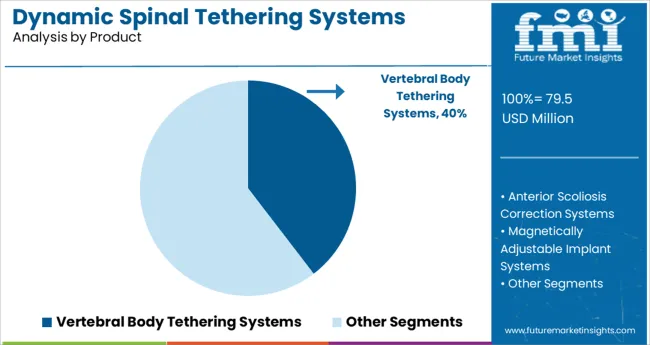
The vertebral body tethering systems segment is projected to capture 39.6% of the market revenue in 2025, establishing itself as the leading product category. Growth is fueled by the system’s minimally invasive nature and its ability to correct spinal curvature without fusion. This product offers flexibility, allowing continued spinal growth and mobility, which is particularly important for pediatric patients.
Surgeons favor vertebral body tethering for its reduced recovery times and lower risk of complications compared to traditional fusion. The system’s adaptability to varying degrees of scoliosis severity has broadened its clinical use. Additionally, advancements in tether materials and implantation techniques have enhanced treatment effectiveness, reinforcing its market position.
The vertebral body tethering segment’s leadership is expected to continue as more clinicians adopt this innovative approach.
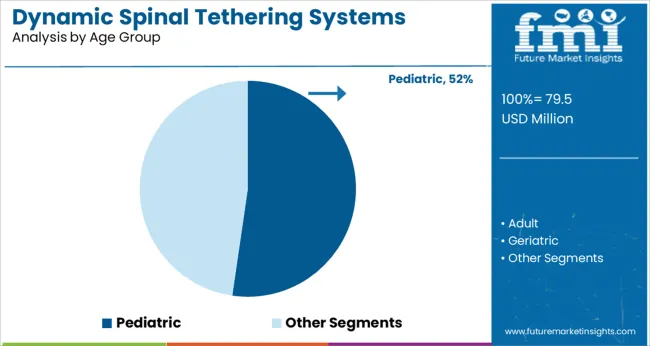
The pediatric segment is expected to hold 52.3% of the dynamic spinal tethering systems market revenue in 2025, reflecting its dominance in patient demographics. Early intervention in children with spinal deformities is critical to preventing progression and minimizing long-term complications. The flexibility and growth-friendly nature of dynamic tethering systems make them ideal for this age group.
Pediatric orthopedic specialists prioritize these systems due to their ability to modulate spine growth while maintaining motion. Increasing scoliosis screening programs in schools and pediatric clinics have led to earlier diagnosis and treatment, driving demand.
Caregivers and healthcare providers alike have shown preference for less invasive options with quicker recovery, supporting growth in this segment. The pediatric group is anticipated to remain the primary beneficiary of advancements in dynamic spinal tethering technologies.
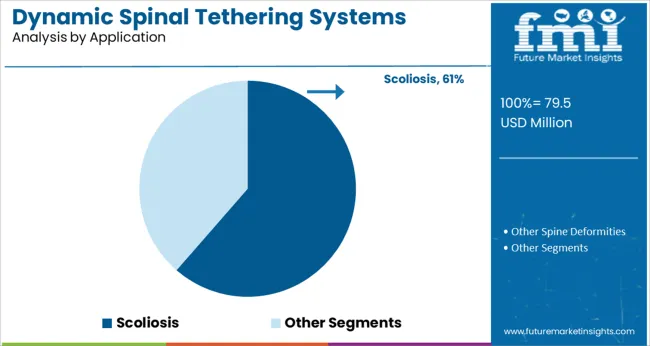
The scoliosis segment is projected to account for 61.4% of the market revenue in 2025, establishing it as the dominant application area. Scoliosis, characterized by abnormal lateral curvature of the spine, is one of the most common indications for spinal tethering. The rising incidence of scoliosis diagnosis, especially among children and adolescents, has sustained the need for innovative correction methods.
Dynamic spinal tethering systems provide an alternative to fusion that allows for correction while preserving spinal flexibility. Increasing clinical evidence supporting improved outcomes with tethering over traditional surgery has bolstered adoption.
Rehabilitation protocols tailored to scoliosis patients further enhance treatment success. The segment’s prominence is reinforced by growing public awareness and healthcare initiatives aimed at early detection and management. The scoliosis application is expected to continue driving the market’s expansion.
The global dynamic spinal tethering system market is being driven by the advantages of dynamic spinal tethering devices in the treatment of spinal abnormalities, particularly scoliosis.
The rising prevalence of scoliosis is likely to fuel the sales of dynamic spinal tethering systems and market's expansion internationally. Increasing product availability of dynamic spinal tethering systems in developing areas is likely to propel the dynamic spinal tethering systems market forward even further.
The superiority of dynamic spinal tethering systems in the treatment of scoliosis and spine deformity over other options is projected to fuel the demand for dynamic spinal tethering systems and the growth of overall market share.
Furthermore, the sales of dynamic spinal tethering devices are predicted to grow due to rising awareness of scoliosis and other spine-related disorders, as well as treatment possibilities.
The global market for dynamic spinal tethering systems is growing due to continued innovation.
Most dynamic spinal tethering system companies work with a sense of urgency and consumer focus in the post-pandemic age to fulfill the rising demand for dynamic spinal tethering systems.
More than 8 million children and adolescents live with scoliosis, according to the American Association of Neurological Surgeons (AANS), which represents a major opportunity to boost the sales of dynamic spinal tethering system in the dynamic spinal tethering systems market
The demand for dynamic spinal tethering system is predicted to develop due to an increase in the number of individuals seeking treatment for scoliosis and other spine problems around the world.
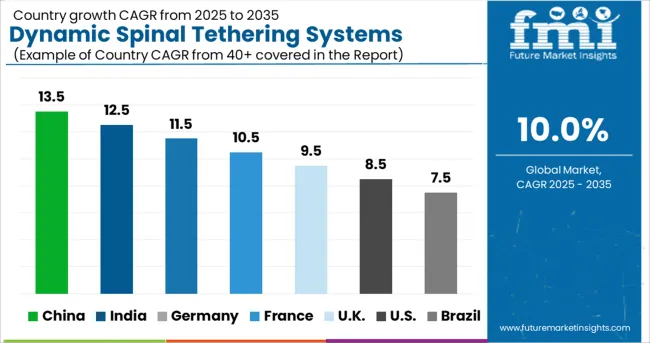
Due to the increased frequency of scoliosis and other spine anomalies, North America is likely to dominate the global dynamic spinal tethering systems market. Furthermore, the demand for dynamic spinal tethering systems is anticipated to grow due to a greater prevalence of treatment-seeking; Europe is predicted to be the second most lucrative area in the global dynamic spinal tethering system market.
Sales of dynamic spinal tethering systems are increasing owing to the rising acceptance of dynamic spinal tethering systems for spine-related abnormalities; Latin America's dynamic spinal tethering system market share is predicted to rise steadily.
Furthermore, Due to rapidly rising product availability and usage, Asia-Pacific is considered an emerging region in the global dynamic spinal tethering systems market. Due to the low rate of treatment-seeking, the Middle East and Africa dynamic spinal tethering system market is predicted to be the least profitable.
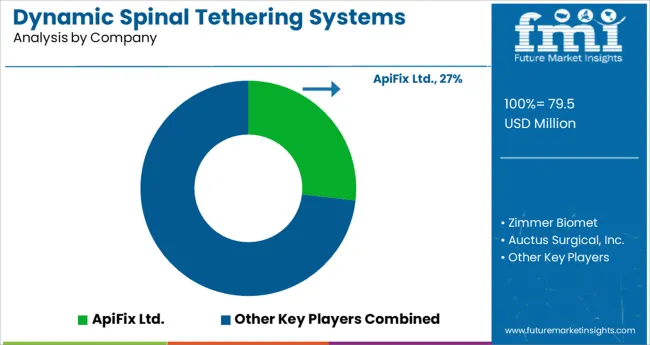
The key players in the global dynamic spinal tethering systems market are INTUITIVEX, Medtronic, Alphatec Spine, Inc., Arthrex, Camber Spine, DePuy Synthes, Exactech, Inc., Globus Medical Inc., and others.
Key players in the global dynamic spinal tethering systems market are continually updating their product portfolios. To dominate the market, they have used a variety of organic and inorganic techniques such as partnerships, enhanced product launches, collaborations, and acquisitions.
| Report Attribute | Details |
|---|---|
| Growth rate | CAGR of 10% from 2025 to 2035 |
| Base year for estimation | 2024 |
| Historical data | 2020 to 2024 |
| Forecast period | 2025 to 2035 |
| Quantitative units | Revenue in million and CAGR from 2025 to 2035 |
| Report coverage | Revenue forecast, volume forecast, company ranking, competitive landscape, growth factors, and trends, Pricing Analysis, |
| Segments covered | Application, end user, region |
| Regional scope | North America; Western Europe; Eastern Europe; Middle East; Africa; ASEAN; South Asia; Rest of Asia; Australia and New Zealand |
| Country scope | USA, Canada, Mexico, Germany, UK, France, Italy, Spain, Russia, Belgium, Poland; Czech Republic, China, India, Japan, Australia, Brazil, Argentina, Colombia, Saudi Arabia, UAE, Iran, South Africa |
| Key companies profiled | INTUITIVEX; Medronic; Alphatec Spine; Inc.; Arthrex; Camber Spine; DePuy Synthes; Exactech; Inc.; Globus Medical Inc. |
| Customization scope | Free report customization (equivalent to up to 8 analysts working days) with purchase. Addition or alteration to country, regional & segment scope. |
| Pricing and purchase options | Avail customized purchase options to meet your exact research needs. |
The global dynamic spinal tethering systems market is estimated to be valued at USD 79.5 million in 2025.
It is projected to reach USD 206.1 million by 2035.
The market is expected to grow at a 10.0% CAGR between 2025 and 2035.
The key product types are vertebral body tethering systems, anterior scoliosis correction systems, magnetically adjustable implant systems and growing rod systems.
pediatric segment is expected to dominate with a 52.3% industry share in 2025.






Full Research Suite comprises of:
Market outlook & trends analysis
Interviews & case studies
Strategic recommendations
Vendor profiles & capabilities analysis
5-year forecasts
8 regions and 60+ country-level data splits
Market segment data splits
12 months of continuous data updates
DELIVERED AS:
PDF EXCEL ONLINE
Dynamic Positioning System Market Size and Share Forecast Outlook 2025 to 2035
Dynamic Vapor Sorption Analyzer Market Size and Share Forecast Outlook 2025 to 2035
Dynamic Plantar Tactile Instrument Market Size and Share Forecast Outlook 2025 to 2035
Dynamic Random Access Memory (DRAM) Market Size and Share Forecast Outlook 2025 to 2035
Dynamic Data Management System Market Report – Trends & Forecast 2023-2033
Dynamic Mechanical Analyzer Market
High Dynamic Range Market Size and Share Forecast Outlook 2025 to 2035
Microsoft Dynamics Market Trends - Demand & Forecast 2025 to 2035
Automotive Dynamic Spotlight Market
Computational Fluid Dynamics (CFD) Market – Trends & Forecast 2025 to 2035
Spinal Pumps Market Size and Share Forecast Outlook 2025 to 2035
Spinal Injectable Market Size and Share Forecast Outlook 2025 to 2035
Spinal Implants and Devices Market Size and Share Forecast Outlook 2025 to 2035
Spinal Devices Market Size and Share Forecast Outlook 2025 to 2035
Spinal Cord Stimulators Market Growth - Trends & Forecast 2025 to 2035
Spinal Osteosynthesis Units Market Trends – Industry Forecast 2025 to 2035
Spinal Stenosis Market – Growth & Demand 2025 to 2035
The Spinal Fusion Market is segmented by Product, Procedure and End User from 2025 to 2035
Spinal Imaging Market Trends – Growth, Demand & Forecast 2022-2032
Spinal Motion-Preservation Devices Market

Thank you!
You will receive an email from our Business Development Manager. Please be sure to check your SPAM/JUNK folder too.
Chat With
MaRIA